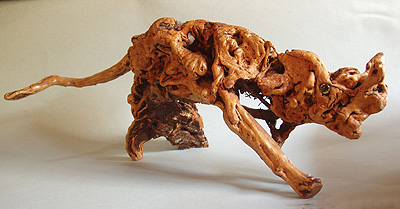
The Zymoglyphic Museum's Department of Special Collections has recently acquired for its curiosity cabinet this fine example of a root carving, a folk art tradition that goes back at least 2,000 years in China. Root carving is one of a number of Chinese and Japanese arts based on creating art from nature, with the focus on the natural characteristics of the object. We have previously covered ikebana, the Japanese art of arranging natural objects, and viewing stones, or scholar's rocks, which are complex stones presented for contemplation.
In this root carving, the anonymous artist has created an image not of a specific animal, but a dynamic creature of the imagination, full of life force, complete with hints of bones, sinews, musculature, and body cavities, all done through simple but effective highlighting of the natural features of the selected object.
A related folk art form is the carving of bamboo root, whose whiskery texture lends itself well to making intriguing masks. The museum has recently acquired an example of one of these masks, made by a member of the Tamang tribe of Nepal.